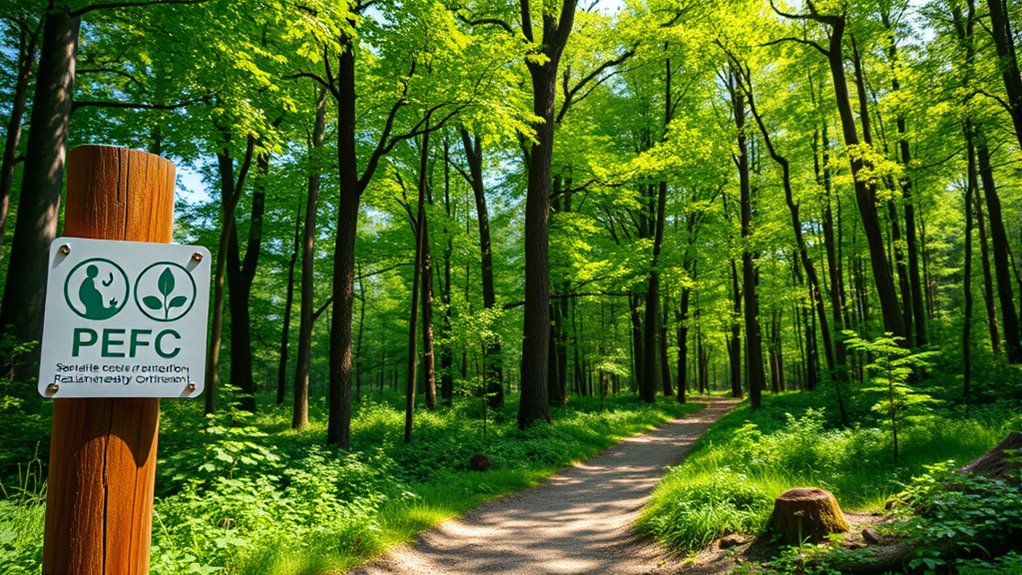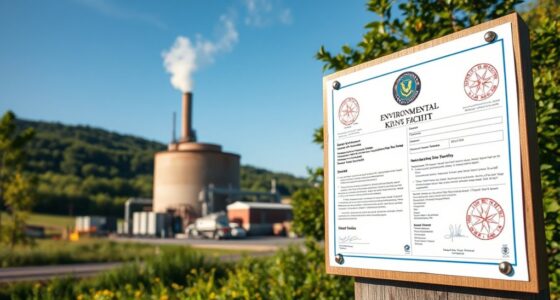Sustainable forestry certifications verify that wood products come from responsibly managed forests, supporting eco-friendly practices and biodiversity. Key programs like FSC and PEFC set standards for ecological health, social fairness, and responsible harvesting. The certification process involves assessments and ongoing audits to guarantee compliance. Choosing certified products helps promote reforestation, fair labor, and environmental stewardship. To understand how these systems work and their rising importance, explore further details on certification standards and future trends.
Key Takeaways
- Sustainable forestry certifications verify eco-friendly wood sourcing, emphasizing biodiversity, reforestation, and responsible land management.
- Major programs include FSC and PEFC, which assess ecological, social, and economic standards through audits.
- Certification involves initial assessments, chain-of-custody tracking, and ongoing third-party audits to ensure compliance.
- Benefits include promoting responsible ecosystem management, reducing deforestation, and supporting ethical supply chains.
- Challenges involve high costs, limited access for small landowners, and potential greenwashing without rigorous oversight.
What Are Sustainable Forestry Certifications?

Have you ever wondered how you can tell if wood products are environmentally responsible? Sustainable forestry certifications are designed to help you do just that. They verify that forests are managed with practices supporting reforestation incentives, ensuring new trees are planted to replace harvested ones. These certifications also prioritize biodiversity preservation, protecting various plant and animal species within forest ecosystems. When a product bears a certification label, it indicates that the forest management meets strict environmental standards. This means responsible harvesting, conservation efforts, and sustainable land-use practices are in place. By choosing certified wood products, you support forest health and contribute to the global effort to maintain natural habitats. Certifications serve as a trustworthy guide for consumers committed to eco-friendly choices. Additionally, sustainable forest management emphasizes growing and harvesting practices that maintain the ecological balance of forests over time. Incorporating forest management standards helps ensure that the ecological functions of forests are preserved for future generations. Furthermore, adhering to these standards often involves ongoing monitoring and certification programs that uphold consistent environmental performance.
Major Certification Programs and Their Standards

Are you familiar with the leading certification programs that verify sustainable forestry practices? These programs set the benchmark for responsible forest management through strict certification standards. The Forest Stewardship Council (FSC) is one of the most recognized, emphasizing ecological health, social benefits, and economic viability. Another major program is the Programme for the Endorsement of Forest Certification (PEFC), which promotes national certification standards that align with global sustainability principles. Both programs ensure forests are managed responsibly, protecting biodiversity and respecting indigenous rights. By choosing products with these certifications, you support sustainable forestry practices. Understanding these certification standards helps you make informed choices that contribute to preserving forests for future generations.
The Certification Process: How It Works

Understanding how the certification process works is key to recognizing what goes into verifying sustainable forestry practices. First, a forest operation undergoes an initial assessment, where auditors evaluate compliance with certification standards. Second, the process involves establishing a chain of custody to track certified products from forest to consumer, ensuring integrity throughout. Third, third-party audits are conducted periodically to verify ongoing adherence to sustainability standards. These audits are independent, objective reviews that confirm your operation’s practices meet certification requirements. The process is transparent and rigorous, helping you demonstrate responsible forest management. Additionally, maintaining proper juice extraction from the forest products ensures the integrity and sustainability of the certified supply chain. Incorporating ethical standards into your management practices further reinforces your commitment to sustainability. Regular compliance monitoring is essential to address any issues promptly and maintain certification status. Staying informed about industry trends can help you adapt your practices to evolving standards. By following these steps, you ensure your products carry credible certification, boosting consumer trust and supporting sustainable forestry efforts.
Benefits of Choosing Certified Forest Products

Choosing certified forest products guarantees you’re supporting responsible management practices that protect ecosystems and local communities. One key benefit is the eco label credibility, which assures you that the products meet strict environmental and social standards. This transparency boosts your confidence as a consumer, knowing your choices promote sustainability. Increased consumer awareness plays a crucial role, encouraging companies to prioritize eco-friendly practices and improve their certification efforts. By selecting certified products, you help reduce deforestation, conserve biodiversity, and promote fair labor practices. This conscious decision aligns your purchasing power with environmental stewardship, making a tangible difference. Additionally, understanding the interconnectedness of individual and collective energy highlights how consumer choices can influence broader environmental outcomes. Recognizing the importance of sustainable resource management can further motivate responsible purchasing decisions. Supporting certified forest products also fosters a responsible supply chain, which values sustainability and ethical stewardship, benefiting both the environment and local communities. Furthermore, cultivating a culture of sustainability among consumers can accelerate positive change across industries.
Challenges and Criticisms of Certification Schemes

You might notice that certification schemes can be expensive and hard to access, especially for small landowners. Some schemes also face criticism for allowing companies to use green promises as a marketing tool without real environmental benefits. These issues raise questions about how effective and fair certification programs truly are. Additionally, the credibility of these programs can be compromised if they do not incorporate transparent standards and rigorous oversight. Implementing standardized criteria could enhance trust and accountability in certification processes. Moreover, integrating independent audits can further ensure that claimed environmental benefits are genuinely achieved. Incorporating necessary cookies and other cookie categories can help improve transparency and user trust in certification claims by providing clear information about how data is collected and used.
Certification Costs and Accessibility
Are certification costs truly accessible for all stakeholders in sustainable forestry? Cost barriers can limit participation, especially for small landowners and local communities. High fees and ongoing expenses make it difficult for some to gain market access through certification. To understand this better:
- Certification costs can be prohibitive, preventing smaller operators from participating.
- Limited market access for uncertified products hampers economic opportunities for local stakeholders.
- The expense of maintaining certification can deter long-term commitment, especially where profit margins are thin.
- Additionally, the cost structure of certification schemes can vary widely, impacting their overall affordability and accessibility. Recognizing that administrative complexity can also add to financial burdens, streamlining certification processes is crucial to enhance inclusivity.
These issues highlight that while certifications aim to promote sustainability, their financial demands can unintentionally restrict inclusive participation. Addressing affordability and streamlining processes are essential steps toward making certification more accessible for everyone involved in sustainable forestry.
Potential for Greenwashing
While certification schemes aim to promote genuine sustainability, they can sometimes be exploited to give a false impression of environmental responsibility. This creates greenwashing risks, where companies may meet minimal standards or manipulate their claims to appear eco-friendly without meaningful action. Such practices can mislead consumers and undermine trust in certification labels. Transparency concerns also arise when certification bodies lack rigorous oversight or fail to disclose detailed assessment processes. As a result, you might assume a product is sustainably sourced, only to discover shortcuts or insufficient standards behind the certification. It is crucial to critically evaluate the credibility of schemes and look for transparent, third-party verification to avoid falling for greenwashing tactics that distort the true state of forestry sustainability. Additionally, understanding the regulatory frameworks that govern certification standards can help ensure that claims are accurate and trustworthy. Recognizing the importance of independent audits can further strengthen confidence in certification claims and prevent potential manipulation. Furthermore, consumers should be aware of the verification procedures used by certifying organizations to better assess the legitimacy of sustainability claims. Incorporating ongoing monitoring can also help verify that certified practices are maintained over time and meet evolving standards.
The Future of Forest Certification and Sustainable Management

The future of forest certification will likely include new standards that address evolving environmental and social concerns. You’ll see increased integration with climate goals, making certifications more aligned with global sustainability efforts. Advances in technology will also play a key role, helping you manage forests more efficiently and transparently.
Emerging Certification Standards
What does the future hold for forest certification standards as sustainability demands evolve? You can expect innovative standards to emerge, addressing gaps in existing frameworks and emphasizing transparency. These new standards will likely prioritize integrated social, environmental, and economic criteria, making certifications more all-encompassing. They’ll also serve as tools for market differentiation, helping companies stand out by demonstrating stronger commitments to sustainability.
- Development of flexible, adaptive standards that respond to changing ecological conditions.
- Greater emphasis on social justice and community involvement in certification processes.
- Increased adoption of digital tools for verification and traceability, boosting trust.
Together, these emerging standards will shape the future of sustainable forest management, aligning market expectations with real-world conservation efforts.
Integration With Climate Goals
As climate change accelerates, integrating forest certification standards with global climate goals becomes increasingly essential. You need to align certification practices with commitments to achieve carbon neutrality, reducing greenhouse gas emissions from forest activities. This involves promoting sustainable harvesting and reforestation efforts that enhance carbon sequestration. Certifications can also support climate adaptation by encouraging forest management strategies that increase resilience to extreme weather and pests. By embedding these priorities, certification schemes help ensure forests contribute meaningfully to global climate mitigation efforts. This integration not only advances environmental goals but also strengthens the credibility of certification programs, inspiring confidence among consumers and stakeholders. Ultimately, aligning forest management with climate objectives positions you to foster healthier, more resilient forests for future generations.
Technology in Forest Management
How will emerging technologies reshape forest management and certification practices in the coming years? You’ll see drones and AI transform how forests are monitored and managed. Drone monitoring allows you to quickly assess large areas for signs of deforestation, pests, or illegal activities. AI forest analysis helps you interpret data more accurately, predicting forest health trends and optimizing sustainable practices. These advancements enable real-time decision-making, increasing transparency and accountability.
Key innovations include:
- Enhanced monitoring with drones for faster, precise data collection
- AI-driven analysis for better forest health predictions
- Improved certification processes through real-time data validation
Together, these technologies make sustainable forest management more efficient, reliable, and forward-looking.
Frequently Asked Questions
How Do Certifications Impact Local Communities Economically?
Certifications boost local communities economically by promoting sustainable practices that attract responsible buyers and investors. You can see increased economic development as certified forests create jobs and encourage community empowerment through training and local enterprise opportunities. These certifications often lead to better market access, higher incomes, and sustainable growth, helping communities thrive while preserving resources. Ultimately, they foster a resilient local economy rooted in environmentally responsible forestry.
Are Certified Forests More Resistant to Pests and Diseases?
You might wonder if certified forests are more resistant to pests and diseases. They often are, because certification standards promote pest resistance and disease prevention through sustainable practices like maintaining biodiversity and healthy soil. These practices strengthen the forest’s natural defenses, making it less vulnerable to infestations and infections. As a result, certified forests tend to have better resilience, reducing the need for chemical interventions and supporting long-term forest health.
What Role Do Consumers Play in Promoting Sustainable Forestry?
Imagine your choices as a ripple in a pond, shaping the future of forests. Your consumer awareness fuels market influence, encouraging companies to prioritize sustainable practices. When you opt for certified products, you send a clear message that protecting forests matters. By supporting eco-friendly options, you become a guardian of healthy forests, helping to guarantee they thrive for generations. Your actions, big or small, can turn the tide toward sustainable forestry.
How Do Certification Standards Vary Internationally?
You’ll notice that certification standards differ internationally due to variations in forest management practices, legal frameworks, and environmental priorities. These differences influence the certification process, which guarantees forests are managed sustainably according to regional criteria. While some standards emphasize biodiversity, others prioritize legality or social benefits. By understanding these variations, you can better evaluate certification labels and support responsible forest management practices worldwide.
Can Certification Help Combat Illegal Logging Effectively?
You can see that certification helps combat illegal logging by improving timber tracking and enforcement. When you choose certified products, you support strict standards that make it harder for illegal logs to enter the market. Certification enforcement guarantees compliance, making it easier to verify the origin of timber. This transparency discourages illegal activities and promotes sustainable practices, helping protect forests and ensure responsible forestry management worldwide.
Conclusion
Think of sustainable forestry certifications as your compass in a vast forest, guiding you toward responsible choices. Just like a seasoned hiker trusts their map to find the safest path, you can rely on these certifications to navigate toward eco-friendly wood products. By choosing certified, you’re helping guarantee the forest’s health for generations to come—like planting seeds of hope in a thriving, balanced ecosystem. Your choices today shape the vibrant forest of tomorrow.









